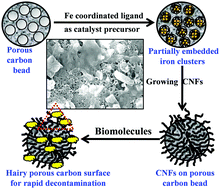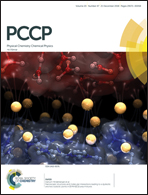‘Nano on micro’ hierarchical porous all carbon structures: an insight into interfacial interactions with bacteria†
Abstract
Micron long carbon nanofibers (CNFs) were grown on porous carbon beads to give an active surface for rapid immobilization of guest molecules. The fabrication of nanostructures using a catalytic route involving chemical vapour deposition on a porous substrate was accomplished by the controlled synthesis of iron nanoclusters on the surface of porous carbon beads. The challenge of catalyst nanoparticle diffusion into the porous substrate was addressed by using iron coordinated ligand complexes and optimizing the loading percentage of metal salts onto beads. The effect of using tethered bottom up surface processed CNFs on the porous beads’ morphologies was established using structural characterization. The protruding architecture of CNFs on the porous carbon surface was subjected to bacterial colonisation in order to determine the efficiency of cell conjugation onto hairy structures, particularly at a low concentration. The interfaces of immobilized bacteria on the textured surface were studied by varying the pH and external physical stimuli to check the biofilm formation. The strategy of fabricating all carbon porous beads, which had topologically controlled ‘nano on micro’ geometries, to give fast immobilization of guest molecules could be useful in the future for developing an active disinfectant surface.



 Please wait while we load your content...
Please wait while we load your content...